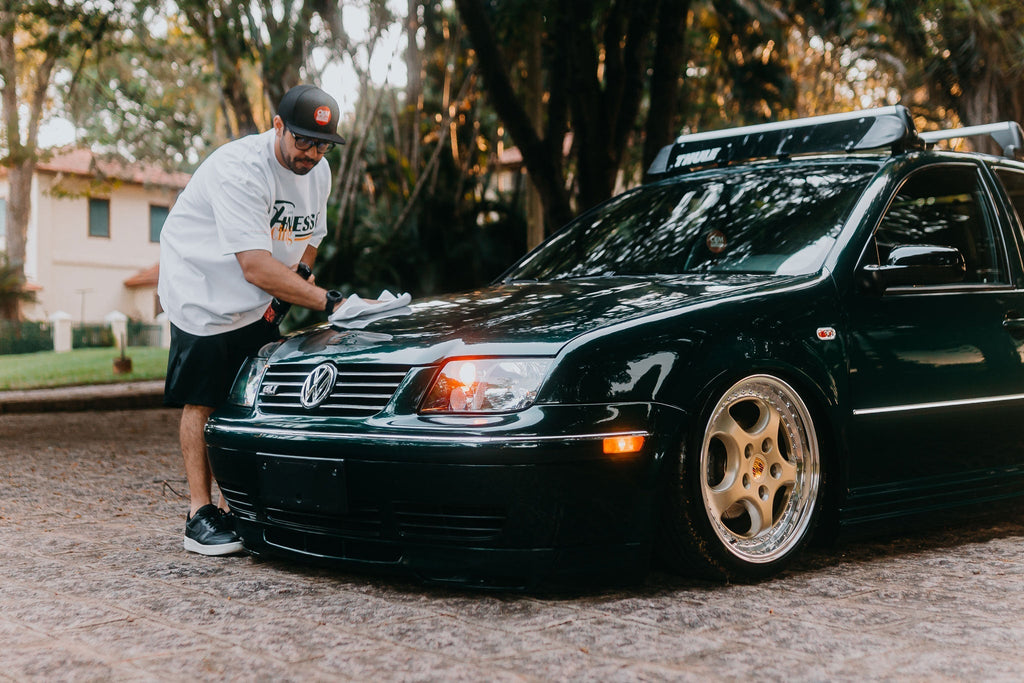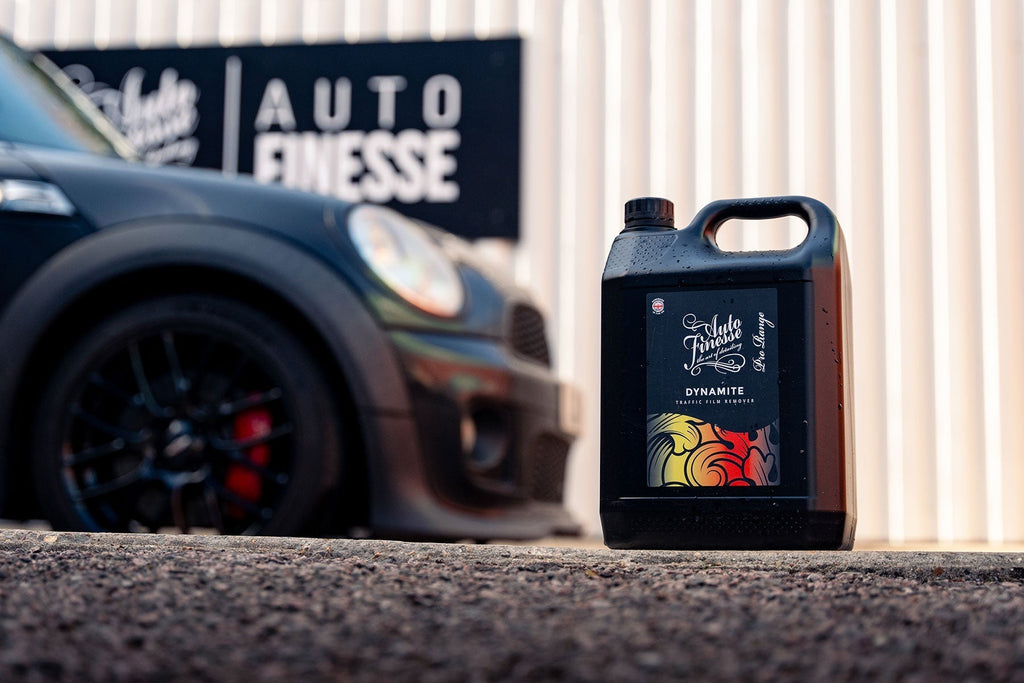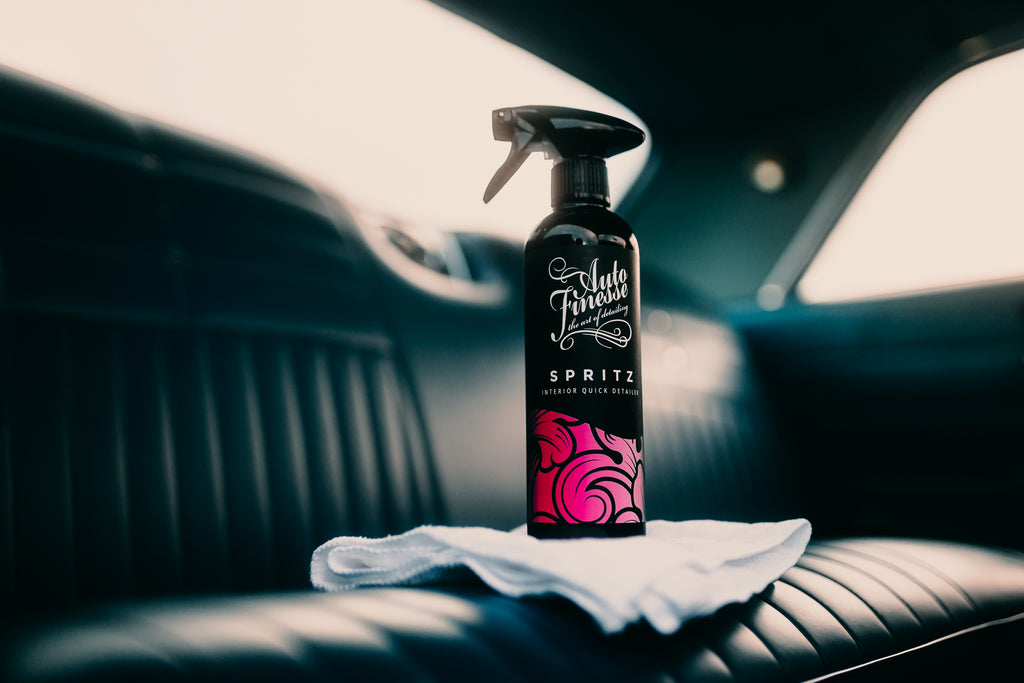Understanding Car Polishes And Compounds

In This Guide You Will:
- Understand the distinctions between car polishes, compounds and liquid waxes.
- Explore what each product is designed to do, their ingredients, and how they function.
- Find the best products to help you achieve a flawless finish.
Master The Differences And Achieve Exceptional Results!
It’s a classic question when it comes to pro-grade detailing products: what’s the difference between a car polish and a car compound? Technically speaking, the difference isn’t significant. However, there’s much more to car polishes, compounds and all-in-one cleaner waxes than it seems. These products often spark confusion about their ingredients and how they function.
With that in mind, let us break it all down and answer the most frequently asked questions to give you the full picture...



What Exactly Is A Car Polish?
Polishes and compounds are detailing products containing abrasive particles designed to carefully remove a thin, often microscopic, layer of a surface. This process, known as "cutting," works by leveling and smoothing the top layer through mechanical abrasion.
In most cases, a car polish refers to a product formulated for vehicle paintwork. Its purpose is to reduce or eliminate visible defects such as swirl marks and scratches. However, it’s important to note that these defects aren’t physically "removed" in the literal sense. Instead, the surrounding paintwork is leveled down to the depth of the deepest part of the defect, effectively making it disappear. Think of it like filling a pothole: by cutting down the surrounding tarmac to make the surface even, the hole is no longer visible. This concept forms the basis of all paint correction techniques.
A standalone polishes and compounds are specifically designed for this corrective purpose. Unlike last step products (LSPs) like waxes, sealants, or ceramic coatings, polishes do not provide any protective layer. LSPs are meant to protect and enhance the finish but lack the abrasives needed to cut or refine paintwork.

What Exactly Is A Compound?
While the term "compound" is often used to describe paint correction products with relatively coarse abrasives, these products are still designed to perform the process of polishing. Technically, this makes them a polish, regardless of the abrasive grade.
The word "compound" actually refers to the product's chemical composition rather than its function. This means all compounds are polishes (since they polish surfaces), and all polishes are chemical compounds. These products are also examples of "suspensions," where solid abrasive particles are suspended in a liquid carrier. The viscosity of the carrier can vary, ranging from a thin liquid to a thick paste.
Polishes and compounds come in various grades, which indicate the coarseness of the abrasive particles in the suspension. The grade determines the "level of cut," or the amount of surface material the product removes. Coarser polishes or compounds have a higher level of cut, removing more material during use.



How Do Abrasive Products Actually Work?
Abrasives work by scrubbing or grinding away the top surface layer until it becomes smooth, which results in greater clarity.
Think of the glass in a picture frame: if it's hazy and foggy, you can't clearly see the image underneath. The same concept applies to paintwork. The outer layer, usually clearcoat, can be filled with defects that obstruct your view of the underlying paint, making the surface look dull and lifeless. By polishing away these imperfections, you improve the clarity of the surface, allowing the true beauty of the paint to shine through. This creates an optical illusion of depth and a shinier appearance.
From a scientific perspective, the effect is related to how light interacts with the surface. If the surface is flawed, on a microscopic level it isn’t perfectly flat. This unevenness scatters the light in various directions, drawing attention to the defects, and also reflects it back from the surface. When the surface is smoothed out, light passes through the clearcoat and reflects back, making the color underneath appear deeper. A flatter, smoother surface also refracts light more evenly, enhancing the gloss and shine. The key point is that it’s the paint beneath the clearcoat that you want to highlight, not the clear layer itself.
The advanced "diminishing" abrasives in our detailing products are designed to break down as they’re worked into the surface. As the abrasives collide and fragment, they become smaller and finer, eventually stopping the cutting action. This is similar to how jagged rocks wear down into smooth pebbles over time. In detailing terms, we call this "working the product through." It’s achieved when the compound stops cutting, and the residue turns clear.
With some products, like Tripple All-in-One Car Polish, these diminishing abrasives are easy to work with, making it suitable for hand polishing. In others, like One Step Compound, the abrasives start coarse but are engineered to extend the cutting range, far surpassing traditional compounds. But we’ll delve more into that shortly.




What Is The Difference Between Cutting And Refining Paintwork?
When it comes to refining paintwork, many people confuse it with cutting, but in reality, refining is essentially a finer version of cutting.
A coarse abrasive with a higher level of cut removes more of the top layer to eliminate deeper defects. However, because the abrasive is coarse, it often leaves behind a hazy or holographic surface, which then needs to be refined to achieve a smoother finish.
Think of it like working with wood: you might start with coarse sandpaper to shape it, then use progressively finer grades to smooth the surface. Similarly, we use finer abrasives to refine paintwork and, when necessary, eliminate the marks left by the coarser abrasives. This process helps light pass through the paint more evenly, enhancing its gloss. That’s why, in a multi-stage correction process, you begin with the coarsest compound to remove the most noticeable defects, then move to finer compounds to refine the finish. This principle is also the foundation of our Revitalise V2 System, which includes three progressively finer compounds. Our Pro Compound Kit also offers three pro-grade machine polishing compounds to take you through all levels of cutting and refinement. Our collection of polishing compounds are designed for professional results at home, and are also available in comprehensive bundles such as our Master Machine Polishing Kit and Complete Machine Polishing Kit which include our full body DPX Dual Action Machine Polisher.
The goal of refining paint is to make the surface as smooth as possible on a microscopic level. While you may not see these minute imperfections with the naked eye, they still exist. It's like looking through a piece of glass: you can see through it clearly, but the surface still has tiny imperfections. Refining paintwork works in the same way—using fine abrasives to make the surface level at a microscopic scale, rendering those imperfections invisible to the eye.

What Exactly Are All-In-One Polishes?
An all-in-one polish (or compound) offers more than a standard polishing product. Typically, these products are designed to do more than just cut and refine; they also contain additional ingredients that perform various tasks. A great example is Tripple All-in-One Polish, our flagship car polish, which is formulated to clean, refine, and protect all in one step. The fine abrasives in Tripple will lightly refine and restore clarity to the paint, while deep-cleansing solvents remove oxidation. Additionally, it includes glazing agents and carnauba wax, which help fill fine swirls and provide a layer of wax protection. This three-in-one approach not only makes paint enhancement fast and easy but also gives the product its name.
One Step Compound, on the other hand, is a next-generation compound that qualifies as an all-in-one due to its uniquely broad cutting range. Traditional compounds and polishes are limited by their abrasive grade, which can only be broken down to a certain level. This often necessitates using multiple grades during a multi-stage correction. A coarse compound, for instance, will remain coarse until it stops cutting, and the same applies to fine compounds. One Step is different—it starts as a coarse compound and progressively breaks down into a fine compound as you work it, allowing it to continue cutting through all stages. This means it can handle everything from a heavy to medium cut and finish with a refined, flawless result, all without needing to change products or pads along the way.



Do Waxes Work Like Polishes?
In addition to hard waxes, liquid and spray waxes work by leaving a smooth, transparent layer that helps level the optical finish and obscures light defects. They're not like compounds because they contain no abrasives, making them finishing products rather than corrective ones. The key difference, however, is that unlike glazes, all waxes use this layer to provide protection against the elements.
The main difference between liquid, spray, and hard waxes (aside from the obvious liquid form) is their ease of application and durability. Liquid waxes can be either thin, sprayable liquids or cream-like products applied with an applicator. The thinner the liquid, the fewer solids it contains, which typically means less durability. On the other hand, a thinner liquid is easier to apply and buff off. This simplicity of application is one reason why liquid and spray waxes are widely used in the mass market, even though many detailers prefer the durability and finish of hard waxes, like those in our Signature Wax Collection, despite the extra effort involved in their application.
Unlike a car polish or compound, which is a suspension, liquid or spray waxes are technically a solution. This means the solid solute (natural wax, synthetic wax/polymers, or wax emulsion) is dispersed in a liquid solvent. When applied, the solvent evaporates or flashes off, leaving behind the protective wax layer. The thinner the liquid, the quicker the product is to use.
Take a look at our Glisten Spray Wax, a solvent-based spray wax infused with wax emulsion. With its spritz-and-wipe application, Glisten is incredibly easy to use, offering a deep gloss ideal for topping up previously applied wax layers. It provides around a month of protection and enhances water-beading. Glisten is versatile, suitable for all paint types, including matte and satin vinyl wraps, and perfect for treating hard-to-reach areas like panel gaps and shuts.
Glisten is great for stand-alone use or as a top-up for previously applied hard waxes, adding a layer of protection and a beautiful finish with every detail.










Glisten is a high-tech spray car wax specifically developed for a speedy finish with 4-weeks of protection and acres of gloss… and all with nothing more than a... See product details More
So, that should give you the full rundown on different polishes and compounds… with a few glazes and protection products thrown in for good measure.
Check out more top product knowledge in the Guides Section Of Our Blog.





























